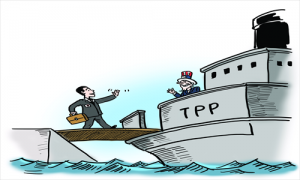Considerations for Japan as they participate in TPP.
Yuriko Koiki writes: After years of exhausting – and exhaustive – haggling, a dozen Pacific Rim countries finally signed up to the Trans-Pacific Partnership (TPP), an agreement that promises everything from more trade to a cleaner environment. The negotiations were such that the hair of Akira Amari, Japan’s economic and fiscal policy minister, turned completely grey. His solace, however, is that the TPP will prove to be a key foundation stone of the “Asian Century.”.
China’s exclusion was no accident. Its huge and complex economy would have injected insuperable problems. In response, China has launched its “Silk Road” initiative to create an economic zone that will favor its own priorities. It is also seeking greater trade cooperation with European countries. One example is President Xi Jinping’s recent visit to the United Kingdom – which in essence is also an attempt to weaken Britain’s “special relationship” with the US by creating a cat’s cradle of trade, financial, and investment ties with Britain.
But, as Japanese Prime Minister Shinzo Abe’s recent call for talks with China on the issue confirm, the TPP is not off-limits to China – or to other Asian economies. South Korea is warming to the idea of the TPP, as is Indonesia, following President Joko Widodo’s recent visit to Washington, DC.
For Japan, the TPP is vital to achieve economic liberalization – the third arrow of “Abenomics,” the government’s program to revitalize the country’s ailing economy. The legislation to enact the TPP will simply push aside the lobbies and vested interests that have been so effective in slowing down or diverting piecemeal reforms.
The promise of greater exchange of goods, services, and capital across the Pacific, as well as the creation of international standards (for example, for intellectual-property rights), is simply too appealing to ignore. When Japan and other Asian countries weigh the risk of implementing the TPP against the risk of not participating, the risk of not participating is overwhelmingly higher.
Japan’s political challenge will be to sell the TPP to its voters, especially the farm lobby. The customs duty on beef imports, for example, is currently 38.5%. It will be 27.5% in the first year after the TPP takes effect, and will then be gradually lowered to 9% in the agreement’s 16th year.
That should surely provide more than enough time for Japanese beef ranchers to prepare themselves for foreign competition (of the 870,000 tons of beef imported annually, 520,000 tons come from Australia, the US, and New Zealand). And it will certainly be a boon for consumers, as the price of their beef-noodle soup and sukiyaki falls dramatically.
Japan’s ranchers do need time to adjust. Because they deal with animals, shortcuts cannot be taken, and there are limits to mechanization, particularly in creating the type of beef that Japanese consumers demand. Whereas ranchers in Australia and the US have huge herds of cattle, Japanese ranchers raise each individual cow on beer and massages.
The same applies to rice. Rumor has it that when the wife of a certain Chinese leader visited Japan, she bought a delicious variety of Japanese rice by the ton. Taking advantage of the worldwide sushi boom, Japan needs to emphasize that “real sushi requires Japanese rice,” branding it an exclusive product.
In fact, regardless of whether or not the TPP is implemented, Japan’s farmers must pursue this approach to secure their futures, rather than hoping that protective subsidies continue ad infinitum.
But now comes the truly hard part. The TPP has been signed – but it will not be implemented unless and until it is ratified by the legislatures of countries such as the US and Canada. That process could well be enough to turn Amari’s gray hair white.

